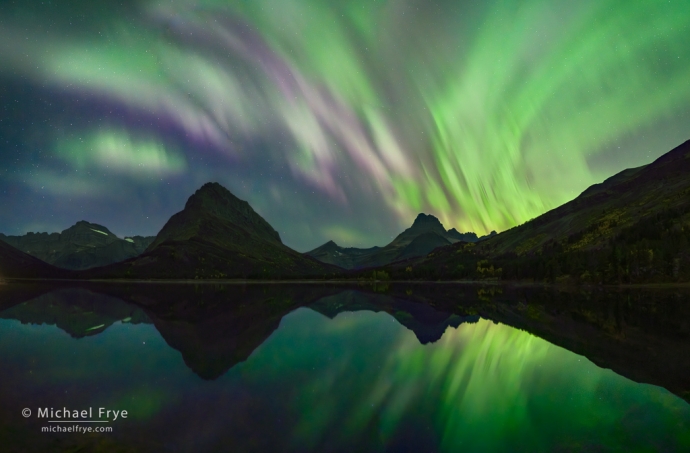
Aurora reflected in Swiftcurrent Lake, Glacier NP, Montana. The aurora was dancing and shimmering at an incredible rate of speed when I made this photo. This is a stitched panorama; four frames, with the camera and 20mm lens turned vertically, blended with Lightroom’s Panorama Merge, and then run through Lightroom’s Denoise. I wasn’t sure if stitched panoramas would work with the aurora moving so quickly, but luckily they did (most of the time). Each frame was 1 second at f/1.8, ISO 6400.
In late September Claudia and I made our annual pilgrimage to the Millpond Music Festival in Bishop, California. Then we drove to Kanab, Utah, for the Nightscaper conference – which turned out to be a super fun event. Kudos to the National Parks at Night team (Lance Keimig, Chris Nicholson, Tim Cooper, Gabriel Biderman, and Matt Hill) for making everything run so smoothly!
After the conference, we planned to just go wherever things looked interesting. We decided to head to southwest Colorado to look for fall color. But as soon as we arrived I started getting alerts about increased solar activity, and the possibility of seeing auroras at mid latitudes.
I missed the big aurora event last May 10th, as I was down in the Grand Canyon, and didn’t even know about it until we emerged. (We probably wouldn’t have been able to see it down there even if we knew.) But we’ve reached the solar maximum – the point in the roughly 11-year solar cycle where solar activity is strongest. That increased solar activity leads to stronger and more frequent coronal mass ejections (CMEs) that, when directed toward earth, create auroras (otherwise known as the Northern Lights or Southern Lights, depending on which hemisphere you’re in).
So I’ve been keeping my antennae up, knowing that I might get more opportunities to photograph the aurora in locations where you usually don’t normally see it. Upon learning about a couple of CMEs headed toward earth, we abruptly changed plans and left southwest Colorado. Our first stop was Dinosaur National Monument, where I knew a spot with an interesting view to the north. The first CME was supposed to arrive the night of October 3rd and 4th, but we saw no sign of the aurora that night. Oh well, it was still a fun side trip to one of our favorite places.
The next CME was supposed to be even stronger, and due to arrive two nights later, on October 5th and 6th. Looking at weather and smoke forecasts, we decided to continue north to Yellowstone. But once again, no aurora. Aurora predictions have become much more accurate in recent years (at least in the short term, up to three or four days in advance), but they’re not perfect, and something didn’t pan out as expected. (It looked like the Earth might have passed through a donut hole in the CME.) Well, okay, we didn’t see the aurora, but got to spend a beautiful night under the stars in Yellowstone.
What next? On our way to Yellowstone we had seen some nice fall color in the Tetons, so we decided to head back there. We were camped in the Gros Ventre campground, and I started to get alerts that auroral activity was increasing. Huh? Nothing in the forecasts had hinted at that. But the Kp Index was pushing up to 5, then 6, then 7. (The planetary K-index, or Kp Index, from NOAA is a scale from 0 to 9, so that’s pretty high.) As it got dark, I took my camera and tripod to the edge of the campground, pointed it north, and made an exposure. Sure enough, the sky was pink and green. “It’s happening!” I told Claudia.
But where could we go nearby to find a good view to the north? From our time in the Tetons last June, I thought maybe the southern end of Jenny lake might work, so we headed there. As we stepped out of the car we could see auroral pillars to the north, and red in the sky to the northeast – only the second time I’d ever seen auroral color with my naked eye.
We grabbed headlamps, bear spray, my camera bag and tripod, and made the short walk out to the lakeshore. The view looking north worked perfectly, and we watched as auroral columns marched by from right to left (east to west). At times we could see the red color with our eyes, but on camera those reds were incredibly vivid. We were even able to make beautiful, hand-held, 3-second exposures with our iPhones in night mode. Here’s my favorite (big-camera) photo from that evening:
After photographing that scene for about 30 minutes, we started to think about where to go next. We couldn’t think of many great views looking north from the Tetons, so… Yellowstone? Okay, why not. We started driving north. But after awhile it became apparent that the aurora was fading, so we turned around, went back to our campsite, and got a few hours sleep before getting up and photographing sunrise.
It was very smoky in the Tetons the next morning. It looked better farther north, so we decided, once again, to drive up to Yellowstone.
That evening we met up with our friends Jennifer Renwick and David Kingham, and then were joined by an old friend from Yosemite who now lives in Montana, Kristal Leonard. We went to one of our favorite geysers, and, for a brief period, photographed more auroral pillars to the north. This display wasn’t as intense as the previous night, but still pretty:
The next day we learned about another, even bigger CME – potentially Kp8 or higher – headed for earth, and due to arrive the night of October 10th and 11th. Unfortunately, weather forecasts for that night looked very cloudy for Yellowstone, and most of the western U.S. The only interesting place we could go within reasonable driving distance with a good chance for clear skies seemed to be Glacier National Park. We hadn’t been to Glacier since 1991! But okay, why not? It was only a six-hour drive.
It turned out that David and Jennifer were also thinking of going to Glacier. Though they needed to get to Oregon for a workshop, they had been in Yellowstone on May 10th, and made some amazing photos that night, so they decided they couldn’t miss the chance to see another potentially stellar night of aurora viewing. And Kristal managed to get time off from work and join us as well.
So the five of us met in Glacier National Park on the evening of October 10th. We arrived early enough to do a little advanced scouting in the daytime, then drove west to Lake McDonald. As were were driving, still at dusk, we could see the aurora out of the car windows. We stopped and viewed the auroral corona directly overhead – something Claudia and I had never seen before.
We continued to Lake McDonald, then worked our way east, stopping at various places along the Going-to-the-Sun Road. On several occasions the aurora faded a bit, but always came back stronger. Sometimes we could see red or green colors with our naked eyes. At times it shimmered and danced, moving so quickly that we needed shutter speeds of 1 second or less to capture the movement. That’s extremely short for night photos, requiring me to push the ISO up to 10,000, or even higher, even at the wide-open f/1.8 aperture on my 20mm lens. But luckily the aurora was bright enough to make that work, and Lightroom’s Denoise tool did an amazing job of reducing noise and retaining sharpness in these photos. I captured some 1500 photographs during the night, mostly just firing off frame after frame of the same composition to try catch the aurora at its best moments.
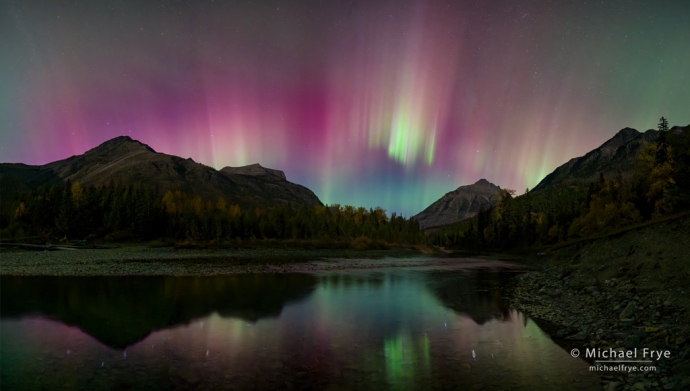
Aurora over McDonald Creek, Glacier NP, Montana. Another stitched panorama, this time five frames. 20mm (oriented vertically), 2 seconds at f/2.0, ISO 10,000.
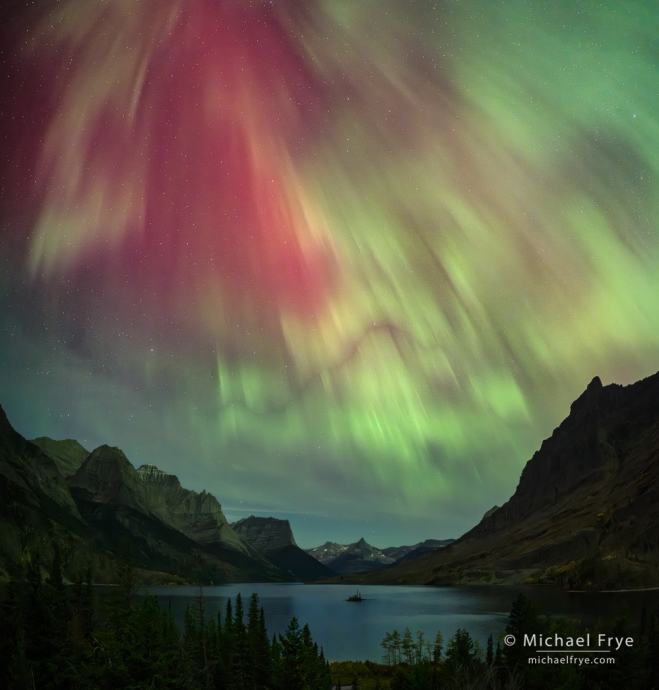
Aurora above St. Mary Lake, Glacier NP, Montana. Two-frame stitched panorama; 20mm (oriented horizontally), 1 second at f/1.8, ISO 10,000.
David and Jennifer were camped on the west side, Claudia and I on the east side, so we parted ways at around 3:00 a.m. at St. Mary Lake. Kristal caught a few hours sleep at our campsite, while Claudia and I decided that we would keep going. How many times would we get to see something like this?
We drove up to Swiftcurrent Lake. We’d never been there before, but it was easy to find, even in the dark. We’d seen many people out enjoying the display of Northern Lights along the Going-to-the-Sun Road, though the numbers diminished as the night wore on. But at 4:00 a.m. we had Swiftcurrent Lake all to ourselves.
And there the aurora seemed to put on a grand finale, shimmering, flickering, and dancing at incredible speeds. It’s hard to describe this if you haven’t seen it. It’s not like it’s morphing and changing from one second to the next. It’s moving and flickering like an old Super 8 film at 30 frames per second. It’s the aurora after 10 cups of coffee – yet serene, quiet, and beautiful. What a spectacular show. (Later we were happy to hear that Jennifer and David had seen the same show from Lake McDonald.)
I made the photograph at the top of this post, perhaps my favorite of the night, looking west over Swiftcurrent Lake, as the aurora was dancing and shimmering at incredible speeds. Later I saw Claudia pointing her iPhone (on a tripod) to the west, and noticed the small, bonsai tree she was looking at, so I worked that tree into a composition – another favorite image from the night:
Finally, around 5:00 a.m., the aurora started to diminish, this time, it seemed, for good. We drove back to our campsite and got some sleep. But what an incredible night. It was an experience we’ll never forget, and it was so much fun to share it with friends.
I hope many of you also got to see the aurora that night! But if not, there’s a good chance we’ll see more bright auroral displays over the coming months before the solar maximum ends. If so, I’ll probably be chasing the aurora again.
— Michael Frye
Related Posts: Yellowstone Aurora; Aurora With Meteors
Michael Frye is a professional photographer specializing in landscapes and nature. He lives near Yosemite National Park in California, but travels extensively to photograph natural landscapes in the American West and throughout the world.
Michael uses light, weather, and design to make photographs that capture the mood of the landscape, and convey the beauty, power, and mystery of nature. His work has received numerous awards, including the North American Nature Photography Association’s 2023 award for Fine Art in Nature Photography. Michael’s photographs have appeared in publications around the world, and he’s the author and/or principal photographer of several books, including Digital Landscape Photography: In the Footsteps of Ansel Adams and the Great Masters, and The Photographer’s Guide to Yosemite.
Michael loves to share his knowledge of photography through articles, books, workshops, online courses, and his blog. He’s taught over 200 workshops focused on landscape photography, night photography, digital image processing, and printing.

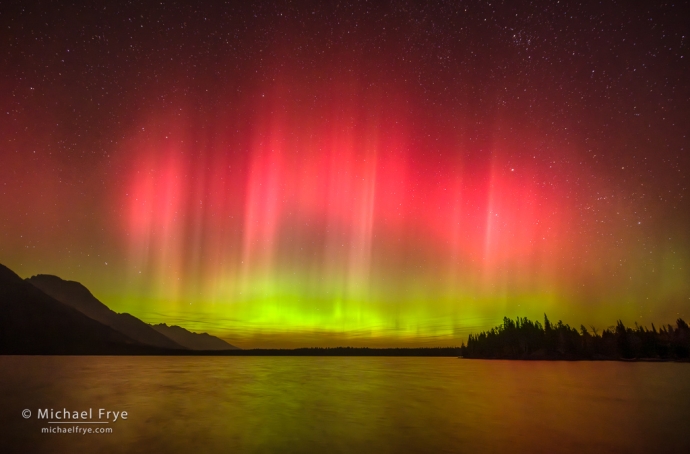
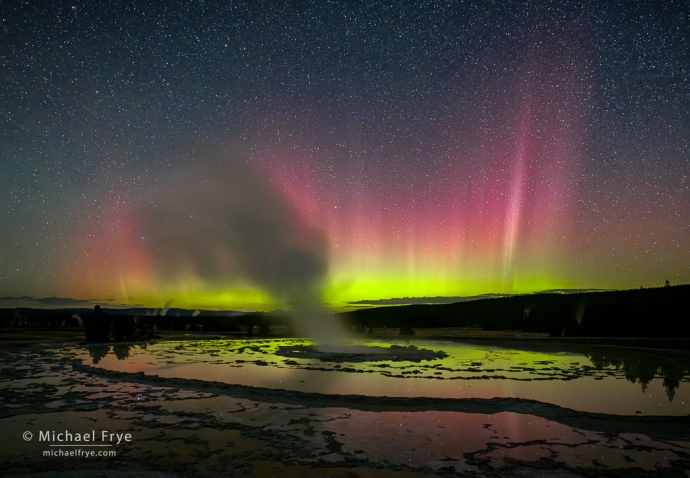
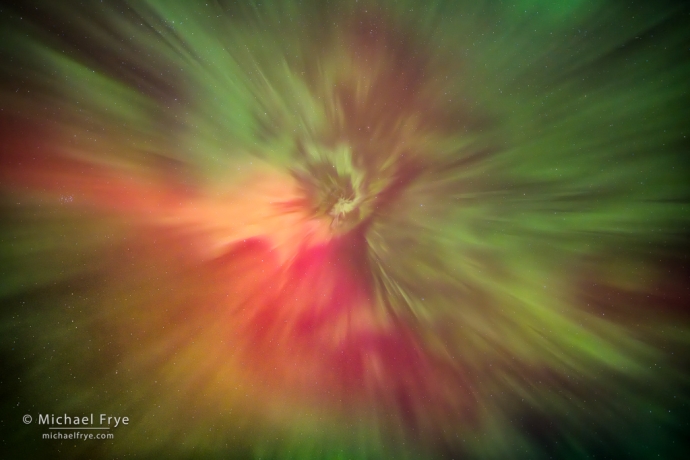
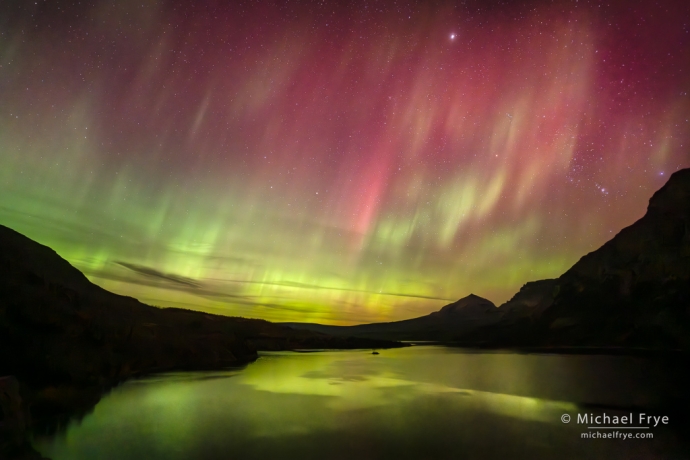
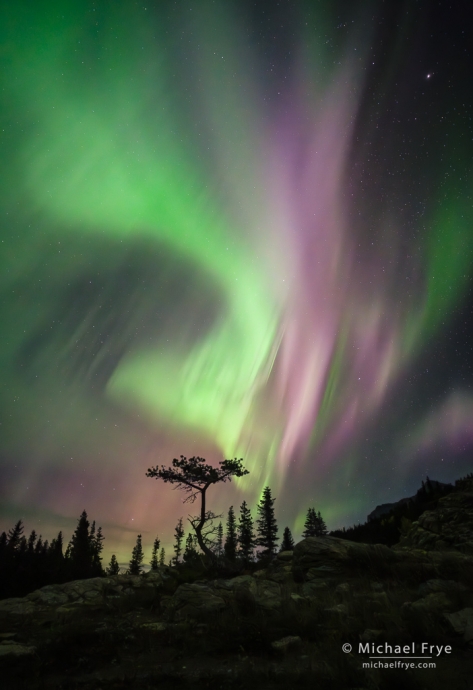
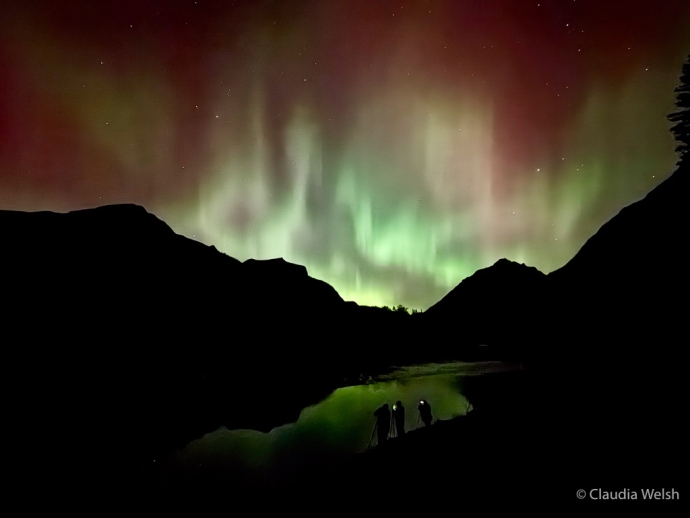








Thank you for sharing these amazing photos and story Michael. We didn’t see anything here in coastal Southern California, so I have Aurora envy. I especially love the geyser and bonsai photos. Take care.
Thanks very much Gery! The aurora was seen near Tucson that night, so it might have been visible that far south. But you’d probably have to get away from city lights.
Wow! Spectacular photos, Michael.
Thank you Dan!
Amazing photos, Michael and the your story is as I would expect from having kept up with you for fifteen years. This is a well told tale not only sharing technique but also sharing your experience and excitement. You make photography an adventure! You can still inspire a septuagenarian.
Thanks so much Jorge! Very much appreciated.
Wow! indeed. When you shoot at super high ISOs, does it limit your ability to make prints?
Thanks Michael! Yes, super-high ISOs can limit how big a print you can make, but it depends on a lot of factors. First, how well noise-reduction software works. Some of the newer tools (especially Adobe’s Denoise), do an amazing job of reducing noise and retaining sharpness, but there are limits to everything. Second, whether you can mitigate the noise by other techniques, like star stacking, or blending a longer exposure for the landscape along with a shorter exposure for the sky. Third, and maybe most importantly, your subjective tolerance level for noise and sharpness (or lack thereof). How persnickity are you?
Thank you for sharing your aurora adventures, Michael! I love all your photos- it’s very difficult to pick a favorite.
Thanks so much Vivienne! You don’t have to pick. 🙂
Absolutely fantastic Michael! That was truly a night I will never forget and I’m so glad we were able to experience it with you guys. It’s so cool you made it to Swiftcurrent, the payoff was certainly worth it. The bonsai tree is my favorite, well seen, Claudia 😉
Thanks very much David! It was an unforgettable night, and so fun to share that experience with you, Jennifer, and Kristal. I look forward to seeing your photos from that night!
Absolutely stunning photos, Michael!! These are THE MOST amazing photos of the northern lights that I’ve ever seen!!
Thanks so much Patti!
Beautiful! The “Geyser and aurora, Yellowstone NP” to me looks as if God reached down and pushed His finger on the button to start the light show.
Thanks so much Denise!
Oh wow, spectacular indeed, in images and words! I’m so glad you and Claudia were there and many thanks for sharing. That same night through our cameras we saw a tiny curtain of red aurora, faintly dancing over the hills east of San Jose California.
At least you saw something! San Jose not being the ideal spot perhaps. 🙂 Thanks Gina, and it was great to see you and Steven in Kanab!
These are so beautiful. Thanks for sharing.
Thank you Joann!
Wow! How lucky were you and so beautifully captured. Really so fantastically beautiful.
I was photographing the Perseids in August in North Carolina and I thought
my camera was broken when I saw a big pink splotch in the LCD. It turned out
to be the aurora! Apparently an unexpected solar flare that night.
Thanks Kathy! I photographed that combination of Perseid meteors and the aurora as well, in Yosemite. And actually the aurora was predicted, but you never know if those predictions will really pan out.
Awesome images, Michael! What a great adventure. The bonsai tree is my favorite. Perfectly seen and photographed.
Thanks very much Fritz!